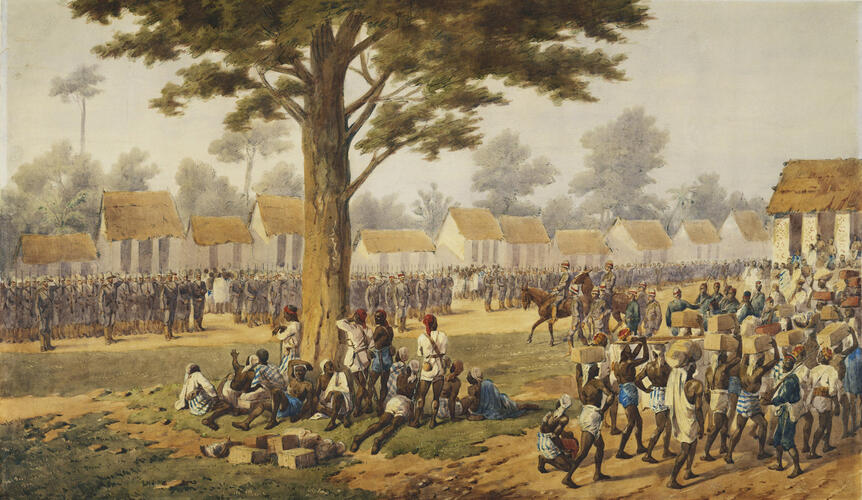-
1 of 253523 objects
Ashanti Campaign: the entry into Kumasi, 4 February 1874 c.1874
58.0 x 98.8 cm (whole object) | RCIN 921572

Orlando Norie (1832-1901)
Ashanti Campaign: the entry into Kumasi, 4 February 1874 c.1874
-
A watercolour depicting British troops standing in rows on the left in front of huts and saluting Sir Garnet Wolseley and his staff, who are on horseback on the right. In the foreground, a group of African men, some of whom are watching the scene, are sitting and standing beneath a large tree while other men appear to be acting as bearers on the right.
The Anglo-Ashanti Wars of the nineteenth century were a series of conflicts between the Ashanti Empire of Africa (now Ghana) and the British Empire, framed by broader European expansion into Africa to obtain territory and natural resources (which were generally taken by force). By the second decade of the twentieth century the vast majority of Africa had been colonised. Following the unification of smaller independent principalities in the region into the Ashanti Kingdom in the eighteenth century, the kingdom grew extremely prosperous through trade in gold, cloth and enslaved people. The 1873-4 Anglo-Ashanti War, which this watercolour relates to, was occasioned by the British purchasing territory from the Netherlands which was claimed by the Ashanti. British forces, led by Sir Garnet Wolseley, sought to punish the Ashanti for subsequent incursions into this disputed territory; British military action culminated in the taking of Kumasi, the capital of the Kingdom, on 4 February 1874. This watercolour depicts this event. Two days later the British forces burnt Kumasi, destroying it. The 1873-4 Anglo-Ashanti War ended shortly afterwards when King Kofi Karikari of the Ashanti agreed to British peace demands. Sir Garnet Wolseley received many accolades for his leadership of the campaign. He became Commander-in-Chief of the British Army twenty years later.
On the right in this watercolour can be seen Black soldiers who are presumably meant to represent figures from the 1st and 2nd West India Regiments, almost 500 of whom served alongside British troops. The West India regiments were formed at the turn of the nineteenth century in the British Caribbean colonies, and were initially made up of enslaved men from Africa who were purchased by the British Army on arrival in the Caribbean. After the prohibition of the trade of enslaved people within the British Empire in 1807, soldiers were recruited from men liberated from ships illegally transporting enslaved people. (See Tim Lockley, 'Creating the West India Regiments', and Melissa Bennett, 'The West India Regiments in the Anglo-Ashanti War, 1873-4', West India Regiments, British Library https://www.bl.uk/west-india-regiment).
Orlando Norie was born into a well-known Scottish artistic family but spent much of his working life in France. He is particularly known as a painter of military scenes, and had a long-lasting professional relationship with the printsellers and publishers Ackermann & Co who managed his picture sales and published lithographs after his drawings, beginning with scenes of the Crimean War in the 1850s. He is not thought to have travelled outside of Europe, and therefore his depictions of colonial military action are not personal eye-witness accounts. The significant group (c.70) of watercolours by Norie now in the Royal Collection primarily came from two sources - Queen Victoria, via purchase or commission, and at least eighteen which were previously in the collection of her son Prince Arthur, Duke of Connaught, who served in the British Army. These were given to the Royal Collection after his death in 1942.
-
Medium and techniques
Measurements
58.0 x 98.8 cm (whole object)
Category
Object type(s)
Subject(s)
Other number(s)
RL 21572